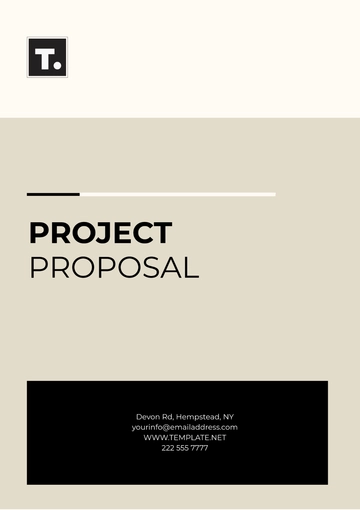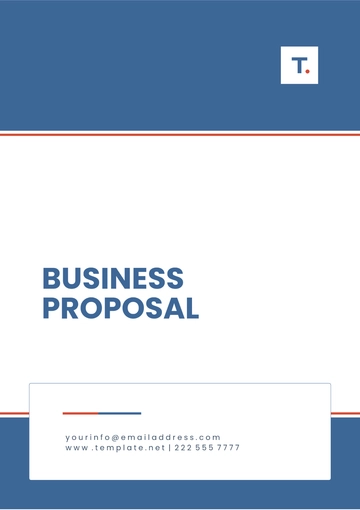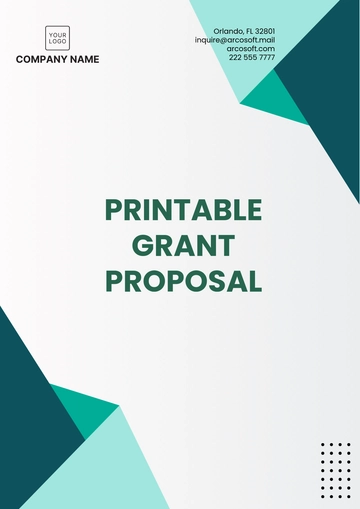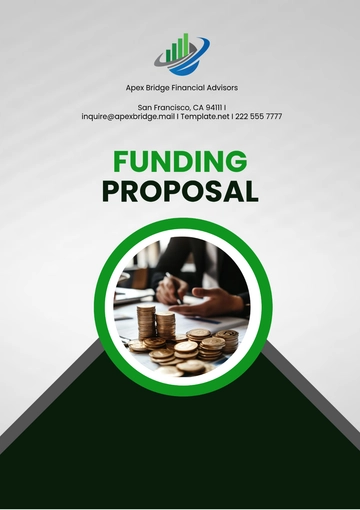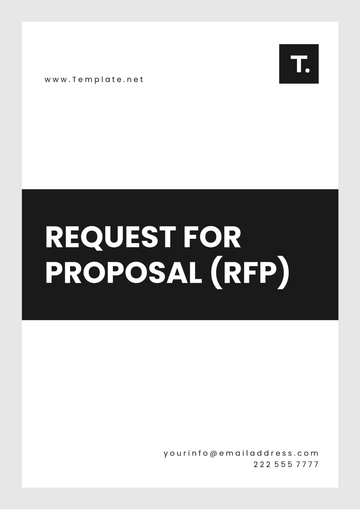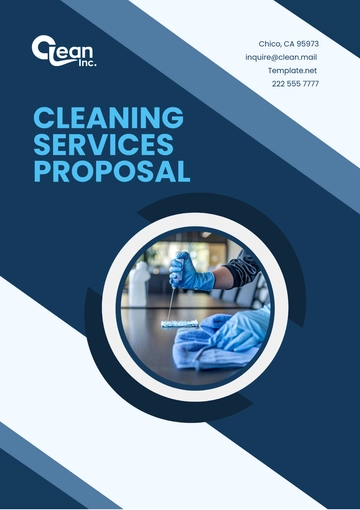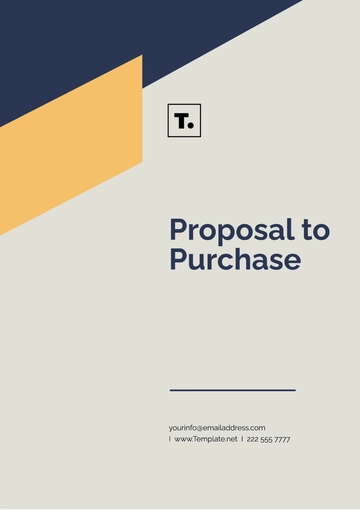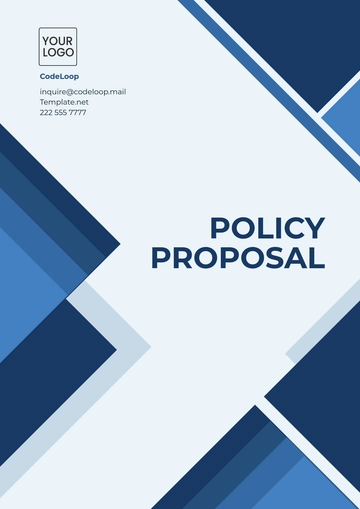Free Health & Safety Proposal
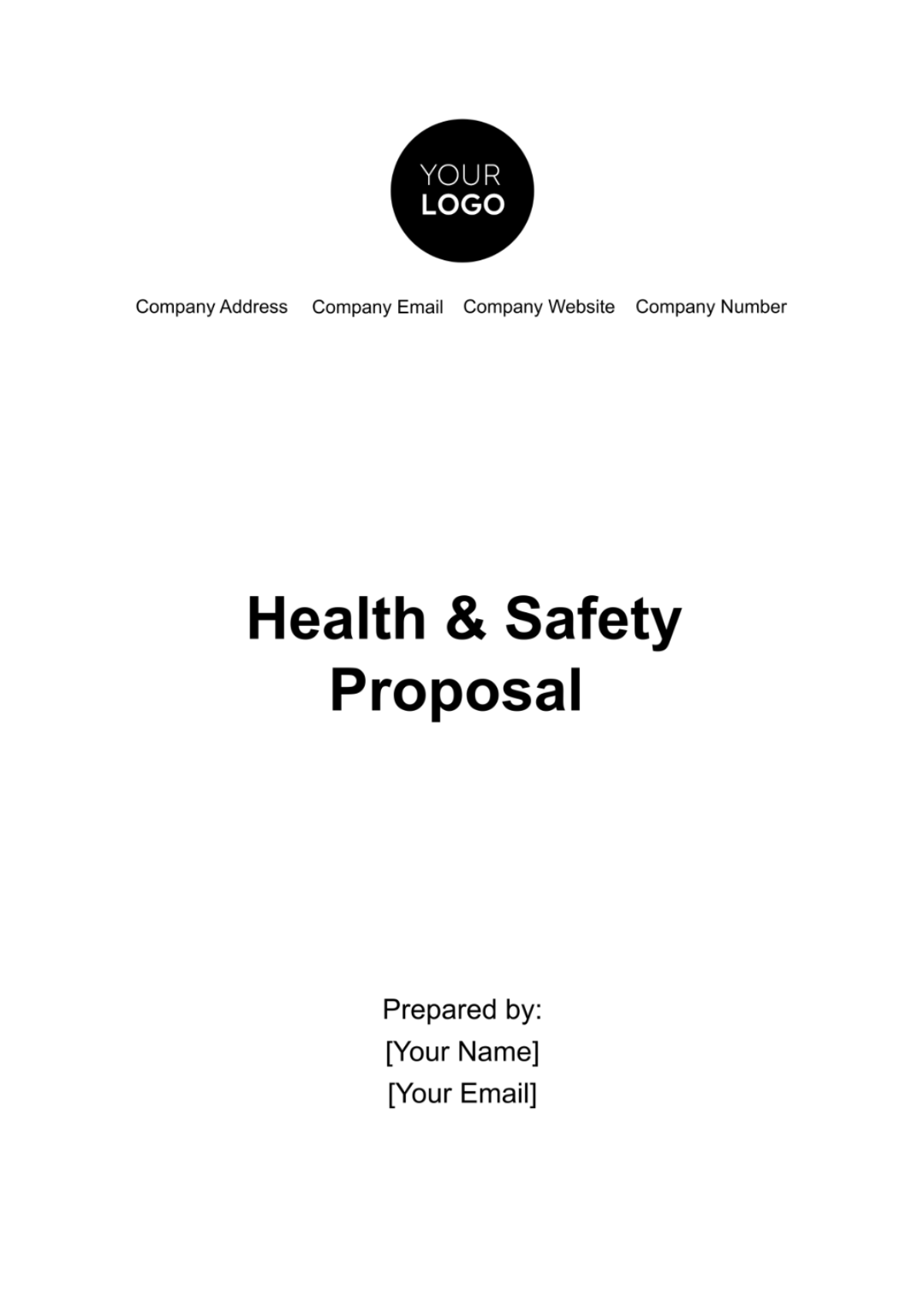
I. Executive Summary
This proposal outlines a strategic initiative to elevate our company's commitment to the safety and well-being of our workforce. Recognizing the importance of a safe working environment, we propose a multifaceted approach to address current challenges and enhance overall safety practices. The key components of this proposal include a comprehensive review of current practices, targeted training programs, hazard identification and mitigation, regulatory compliance measures, and a well-defined monitoring and evaluation framework.
II. Introduction
A. Purpose
This proposal aims to enhance workplace safety, creating an environment where employees can thrive without compromising their health. By implementing robust health and safety measures, we aim to reduce accidents, ensure regulatory compliance, and foster a culture of safety throughout the company.
B. Scope
This proposal encompasses a comprehensive review of current health and safety practices within our company. We will focus on identifying and mitigating existing hazards, implementing effective training programs, and ensuring compliance with relevant regulations. The scope extends across all departments and work processes, fostering a holistic approach to workplace safety.
C. Objectives
1. Enhance Employee Awareness and Training
Increase employee awareness of safety protocols and best practices through comprehensive training programs, empowering them to contribute actively to a safer workplace.
2. Mitigate Workplace Hazards
Implement measures based on identified hazards to mitigate risks and create a safer working environment.
3. Ensure Regulatory Compliance
Ensure that our company adheres to all relevant health and safety regulations, minimizing legal risks and promoting a culture of compliance among employees.
III. Current Situation Assessment
A thorough assessment of our current health and safety practices is essential to identify areas for improvement. The table below provides a summary of the key findings from our recent assessment:
Area of Assessment | Current Status | Identified Issues/Concerns |
Emergency Response | Adequate emergency exits and signage. | Lack of comprehensive emergency response training. |
This examination allows us to identify existing strengths and pinpoint specific challenges, providing a roadmap for tailored enhancements. Through this proactive assessment, we not only address immediate concerns but also pave the way for a sustained culture of safety. The data gathered serves as a benchmark for progress, enabling us to measure the effectiveness of implemented changes and continually refine our health and safety protocols to align with the best practices in the industry.
IV. Regulatory Compliance
Ensuring compliance with local, state, and federal health and safety regulations is fundamental to our proposal. The following table outlines the key regulatory requirements and our proposed actions to meet and exceed these standards:
Regulation | Compliance Status | Proposed Actions |
OSHA Standards | Partial compliance with some standards. | Conduct a comprehensive review and update of safety protocols to align with OSHA standards. |
The results allow us to identify existing strengths and pinpoint specific challenges, providing a roadmap for tailored enhancements. Through this proactive assessment, we not only address immediate concerns but also pave the way for a sustained culture of safety.
V. Methodology
In undertaking the initial assessments for both the Current Situation and Regulatory Compliance, rigorous methodologies were employed to gather accurate and insightful data:
A. Current Situation Assessment
1. Data Collection
Multiple data collection methods were employed, including onsite observations, interviews with key personnel, and a review of incident reports and safety documentation.
2. Employee Feedback
Surveys and feedback sessions were conducted to capture the perspectives of our workforce, providing valuable insights into their experiences and perceptions regarding workplace safety.
3. Collaborative Workshops
Workshops involving cross-functional teams were organized to encourage collaborative identification of potential hazards and safety concerns across various departments.
B. Regulatory Compliance Assessment
1. Regulatory Audit
A comprehensive audit was conducted to assess our adherence to local, state, and federal regulations. This involved reviewing documentation, permits, and other relevant records.
2. Legal Consultation
Collaboration with legal experts was instrumental in ensuring a thorough understanding of existing regulations and standards, guiding our compliance assessment.
3. Industry Benchmarking
Comparative analysis with industry standards and best practices provided additional context to assess the comprehensiveness and effectiveness of our current compliance measures.
VI. Proposed Initiatives
As a direct response to the findings from our compliance and current situation assessments, the proposed health and safety initiatives outlined below represent a strategic plan to fortify our existing safety protocols. These initiatives are designed to address specific areas of improvement and enhance the overall safety culture within our company.
A. Emergency Response Preparedness
1. Initiative
Implementation of Emergency Response Training, this initiative focuses on identifying potential hazards before they become incidents. By systematically inspecting all areas of operation, we aim to create a proactive approach to risk management, thereby enhancing the safety and security of our workplace.
2. Objective
To ensure every employee possesses the necessary skills and knowledge to respond confidently and effectively in emergency situations.
3. Key Activities
3.1 Develop customized training modules.
3.2 Conduct regular drills and simulations.
3.3 Establish an Emergency Response Team for coordination.
B. Hazard Mitigation and Safety Inspections
1. Initiative
Comprehensive Safety Inspections, this initiative focuses on identifying potential hazards before they become incidents. By systematically inspecting all areas of operation, we aim to create a proactive approach to risk management, thereby enhancing the safety and security of our workplace.
2. Objective
To identify, prioritize, and mitigate potential safety hazards in every department, thereby reducing the risk of accidents and injuries.
3. Key Activities
3.1 Conduct regular safety inspections.
3.2 Document and prioritize identified hazards.
3.3 Implement corrective actions promptly.
B. Reporting System
1. Initiative
Implementation of a Reporting System, an efficient hazard reporting system is crucial for maintaining a safe work environment. This initiative aims to simplify and expedite the process of reporting and resolving safety issues, encouraging a culture of transparency and proactive safety management.
2. Objective
To establish a seamless and efficient process for reporting and resolving workplace hazards, thereby enhancing overall safety responsiveness.
3. Key Activities
3.1 Introduce a centralized reporting system.
3.2 Provide training on reporting procedures.
3.3 Establish a responsive resolution process.
C. Employee Well-being Program
1. Initiative
Health Assessments, this initiative is centered around a holistic approach to health and wellness. It aims to regularly assess and proactively support the physical, mental, and emotional health of our workforce, contributing to a healthier, more engaged, and efficient team.
2. Objective
To actively monitor and foster the well-being of each employee, thereby cultivating a healthier, more productive workplace environment.
3. Key Activities
3.1 Implement regular health assessments.
3.2 Provide personalized health feedback.
3.3 Offer resources for improvement.
VII. Timeline for Implementation
The table below outlines the proposed timeline for the implementation of the health and safety initiatives.
Phase | Initiatives | Start Date | Completion Date |
1 | Emergency Response Preparedness Training | [Date] | [Date] |
The proposed timeline for implementing health and safety initiatives is pivotal to the success of our company's commitment to fostering a secure and resilient workplace.
VIII. Budget
The visual representations below provide an estimate of the budget required for the successful implementation of the proposed health and safety initiatives:
Category | Estimated Cost |
Emergency Response Training | $20,000 |
Total Budget |
The budget considerations outlined herein are not merely financial allocations but a strategic investment in the well-being of our workforce. Allocating resources transparently and judiciously across various initiatives demonstrates our commitment to creating a safe working environment.
This budget ensures that each proposed aspect is adequately funded, reinforcing our dedication to comprehensive health and safety enhancements. This proposed budget is a tangible expression of our commitment to prioritize the safety of our employees, bolster our regulatory compliance, and build a resilient and thriving company culture.
IX. Roles and Responsibilities
The following table delineates the roles and responsibilities of key individuals and teams involved in the implementation and maintenance of the health and safety initiatives:
Role | Responsibilities |
Health and Safety Manager | Overall coordination and oversight of the health and safety initiatives. |
Each role outlined in the plays a crucial part in the orchestrated effort to create and sustain a safer work environment. This clear distribution of responsibilities ensures accountability at every level, fostering a culture where safety is not just a priority but an integral part of each team's mandate.
By assigning specific tasks to specialized teams and individuals, we create a collaborative network geared toward achieving our health and safety goals. This helps us to instill a culture of safety, thereby ensuring the well-being and productivity of our workforce.
X. Monitoring and Evaluation
A. Key Performance Indicators (KPIs)
To effectively monitor and evaluate the success of our health and safety initiatives, we will establish key performance indicators (KPIs) that align with our objectives. These indicators will include metrics such as the frequency of safety incidents, response times during emergencies, and employee participation in wellness programs.
B. Regular Audits and Reviews
Scheduled audits and reviews will be conducted at defined intervals to assess the implementation of health and safety initiatives. These evaluations will involve cross-functional teams and external experts to provide an objective perspective on the effectiveness of our programs.
C. Employee Feedback Mechanisms
Creating channels for continuous feedback from employees regarding the effectiveness of health and safety measures is crucial. Regular surveys, focus group discussions, and suggestion boxes will be employed to gather insights, enabling us to make real-time adjustments and improvements.
XI. Conclusion
This proposal aims to provide a strategic approach for cultivating a workplace environment that prioritizes the well-being and safety of our employees. By addressing current shortcomings, aligning with regulatory standards, and introducing targeted initiatives, we aim to foster a robust safety culture.
The proposed timeline, budget considerations, roles and responsibilities, and monitoring mechanisms collectively represent a commitment to continuous improvement. Through the implementation of these measures, we are poised not only to meet regulatory requirements but to surpass them, ensuring a workplace where safety is ingrained in our operations.
- 100% Customizable, free editor
- Access 1 Million+ Templates, photo’s & graphics
- Download or share as a template
- Click and replace photos, graphics, text, backgrounds
- Resize, crop, AI write & more
- Access advanced editor
Elevate safety initiatives with a bespoke proposal tailored to our workplace using Template.net's customizable Health & Safety Proposal Template! This editable gem empowers safety officers to personalize every detail, ensuring our workplace is fortified against risks. Access now and unleash the power of tailored safety proposals to champion workplace safety!
You may also like
- Business Proposal
- Research Proposal
- Proposal Request
- Project Proposal
- Grant Proposal
- Photography Proposal
- Job Proposal
- Budget Proposal
- Marketing Proposal
- Branding Proposal
- Advertising Proposal
- Sales Proposal
- Startup Proposal
- Event Proposal
- Creative Proposal
- Restaurant Proposal
- Blank Proposal
- One Page Proposal
- Proposal Report
- IT Proposal
- Non Profit Proposal
- Training Proposal
- Construction Proposal
- School Proposal
- Cleaning Proposal
- Contract Proposal
- HR Proposal
- Travel Agency Proposal
- Small Business Proposal
- Investment Proposal
- Bid Proposal
- Retail Business Proposal
- Sponsorship Proposal
- Academic Proposal
- Partnership Proposal
- Work Proposal
- Agency Proposal
- University Proposal
- Accounting Proposal
- Real Estate Proposal
- Hotel Proposal
- Product Proposal
- Advertising Agency Proposal
- Development Proposal
- Loan Proposal
- Website Proposal
- Nursing Home Proposal
- Financial Proposal
- Salon Proposal
- Freelancer Proposal
- Funding Proposal
- Work from Home Proposal
- Company Proposal
- Consulting Proposal
- Educational Proposal
- Construction Bid Proposal
- Interior Design Proposal
- New Product Proposal
- Sports Proposal
- Corporate Proposal
- Food Proposal
- Property Proposal
- Maintenance Proposal
- Purchase Proposal
- Rental Proposal
- Recruitment Proposal
- Social Media Proposal
- Travel Proposal
- Trip Proposal
- Software Proposal
- Conference Proposal
- Graphic Design Proposal
- Law Firm Proposal
- Medical Proposal
- Music Proposal
- Pricing Proposal
- SEO Proposal
- Strategy Proposal
- Technical Proposal
- Coaching Proposal
- Ecommerce Proposal
- Fundraising Proposal
- Landscaping Proposal
- Charity Proposal
- Contractor Proposal
- Exhibition Proposal
- Art Proposal
- Mobile Proposal
- Equipment Proposal
- Student Proposal
- Engineering Proposal
- Business Proposal
